
Venereal Disease Treatment Menu: 1 2 3 4 5 6 7 8 9 10 11 12 13 14 Next>>
Venereal Diseases in the Golden Age of Piracy, Page 6
Treating VD During the GAoP
Please be aware that this page contains graphic depictions of the male anatomy.
Before discussing the stages of the Universal Venereal Disease, it should be pointed out that the sea-based medical authors whose books are used here were writing about treating men. Their patient base were sailors who were

Artist: Benjamin Cole
Anne Bonny & Mary Read, From The General History of the Pyrates (1724)
nearly exclusively male. While there are some examples of women going to sea disguised as men during this time, they are so rare as to be statistically irrelevant. If disguised women were discovered on naval, merchant and most pirate ships1, they would be ejected from the crew and put ashore at the first opportunity.
In a case from 1693, a disguised woman was found among a slaving ships' crew by the ship's surgeon when she fell ill. The captain of the vessel explained that "in charity, as well as in respect to her sex, I order’d her a private lodging apart from the men, and gave the taylor some ordinary stuffs to make her woman’s cloaths; in recompence for which she prov’d very useful in washing my linnen, and doing what else she could, till we deliver’d her with the rest at Cape Coast castle."2 The much celebrated two openly female Anglophone sailors widely discussed form this period were among pirate Captain Jack Rackham's crew - Anne Bonny and Mary Read. However, they are statistical outliers, making up an estimated 0.03% of pirate sailors active during the golden age of piracy.3 As a percentage of the total sailors active during the period (including navy, merchant and pirate) this would conservatively be 10 times smaller. The point being that sea surgeons would rarely have to treat female venereal patients which may explain why they don't normally spend much time discussing their treatment in their books directed at sea surgeons.
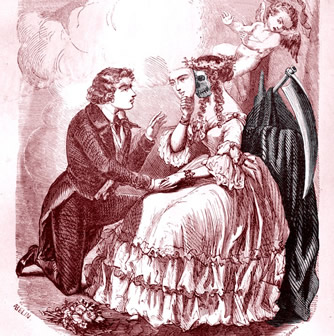
The Two Faces of Love, From Syphilis, Poem in Four Songs,
By
E. Deschamps (1851)
Further, in presenting the method of treatment for venereal diseases it is necessary to look at the problem from the period point of view. We know today that gonorrhea and syphilis are two completely separate diseases, although it is quite possible for one person to contract both at the same time. However, the physicians and surgeons of the time did not recognize this, so understanding their treatment regimen requires viewing the problem in a way which mixes what we today recognize as being different venereal problems together into their Universal Source Theory of venereal diseases.
Their theory basically broke the diseases into two basic parts, one of which includes gonorrhea and the other of which is the third stage of syphilis. John Moyle refers to these two stages as a Clap and a Confirmed Pox. Modern authors often view these two stages as gonorrhea and syphilis, ignoring some of the non-gonorrheal symptoms included by period authors under the more encompassing title of 'Clap'.
Moyle explains that a variety of symptoms which include gonorrhea can occur in the first stage, each of which "or any part of [which] we call but a Clap: Howbeit, it is really the Pox, (a Chip of the same Block) and there is no other difference then only in the Major and Minor."4 While naval physician William Cockburn's book ostensibly focuses on gonorrhea, his explanation of the symptoms of the disease include a variety of those which Moyle associates with the Clap along

Author John Moyle
with symptoms which actually have nothing to do with either gonorrhea or syphilis. Cockburn takes some pains to tie them into the gonorrhea. And, although he doesn't discuss the treatment of the pox, he several times mentions it as the second stage of the Universal Venereal Disease.5
Sea surgeon John Atkins' understanding of the Universal theory combines elements of Moyle's and Cockburn's explanation. Like Moyle, Atkins notes that the Clap is a combination of early symptoms of syphilis and all those of gonorrhea6. Like Cockburn, he turns his focus to gonorrhea, dividing it into benign and malign forms with symptoms that are today recognized as being gonorrheal while basically ignoring the other, non-gonorrheal symptoms found in his own definition of a Clap.7 As both Moyle and Cockburn do, Atkins' goes on to explain that venereal diseases can be broadly seen as having two parts - the early symptoms, many of which are associated with gonorrhea and the later symptoms which are today associated with late stage syphilis.8 Atkins cites Cockburn's book as a source in his section on venereal diseases9 which may explain why he basically abandons his early, broader definition of the Clap in favor of the gonorrhea and pox explanation.
For this article, Moyle's division of the Universal Source Theory into the multi-symptom Clap and Confirmed Pox categories will be used since the details of it make more sense given our modern understanding of the symptoms of syphilis and gonorrhea. Both Atkins and Cockburn discuss two symptoms which, from a modern understanding, are not related to either gonorrhea or syphilis: phimosis and paraphimosis. Even Atkins says, "These I chuse to speak of separately in their Cures"10, suggesting he does not feel them to be an essential part of a Clap.
1 Both Howell Davis and Bartholomew Roberts had articles (rules) specifically prohibiting the men from bringing women aboard their ships. (See Ed Fox, Piratical Schemes and Contracts, 2013, p. 327) Captured merchant captain William Snelgrave explaind this: It is a rule amongst the pirates, not to allow women to be on board their ships, when in the harbour. ...This being a good political rule to prevent disturbances amongst them, it is strictly observed." (Snelgrave, A New Account of Some Parts of Guinea, 1734, p. 256-7); 2 Captain Thomas Phillips, 'A Journal of a Voyage Made in the Hannibal', A Collection of Voyages and Travels, Vol. VI, Awnsham Churchill. ed., p. 179; 3 Ed Fox cites numbers presented by other modern historians in his Piratical Schemes and Contracts, including an estimated "4,000 in total for the decade between 1716 and 1726" and "up to 1,500 European and American pirates were active in the Indian Ocean between 1695 and 1700." (Fox, p. 41) This gives an estimated 5500 pirates for the rough period 1695-1726 resulting in 2/5500 or .03%; 4 John Moyle, Chirugius Marinus: Or, The Sea Chirurgeon, 1693, p. 137; 5 See for example William Cockburn, The Symptoms, Nature, Cause and Cure of a Gonorrhoea, 1713, p. 57-9; 6 John Atkins, The Navy Surgeon, 1742, p. 223; 7 Atkins, pp. 223 & 230; 8 Atkins, p. 239; 9 Atkins, pp. 227 & 237; 10 Atkins, p. 237
Treating VD During the GAoP: First Stage (The Clap)
Although some modern authors suggest that period medical books from this period use 'the Clap' as a euphemism for gonorrhea, sea surgeon John Moyle's explanation gives it broader meaning as already noted. In Chirurgus Marinus, he says that a clap may include any or all of a variety of symptoms which include "a running, which is called Gonorhæa, or pricking heat in the Urethra, or Tumor of the Penis, with Ulcerations call’d Shankers, or Buboe’s in the Groin."1 According to Moyle's explanation, gonorrhea was merely one of several possible symptoms of the 'Minor' stage of venereal diseases which he called the Clap. Sea surgeon 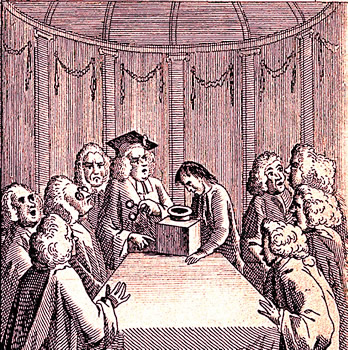
Doctors Debating Theory, From The Devil Upon Two
Sticks,
By William Combe (1771)
John Atkins describes this similarly, including "all those Symptoms commonly understood by a Clap, viz. the Gonorrhæa, Chancre, Phymosis, &c"2. Although he thinks phymosis is a part of the Universal Venereal Disease, he later removes it from the list to treat it separately as already noted.
Even navy physician William Cockburn discusses each of these things in his manuscript on gonorrhea, although his presentation suggests they are all just facets or complications of gonorrhea, itself a part of the Universal Venereal Disease. According to his theory, "the Corrupted Matter of a Gonorrhœa, flowing out of the Penis [the pus flowing out of the urethra], produces a Shanker [chancre]"3.
While German military surgeon Matthias Gottfried Purmann doesn't identify the first stage of the Universal Venereal Disease as cleanly as Moyle does, his explanation of the first part of the disease agrees with the previous authors. "First, this Venom seizes on the Yard... then breaks out into a Gonorrhea, attended with violent heat and pain in making water, and by degrees raises a Swelling, an Inflammation, Rawness, Blisters and Ulcers in the Privities"4.
It is important to note that Moyle recognizes that not all of the symptoms will necessarily appear in the Minor or first stage. He explains "sometimes Buboes or Swellings arise in the Groins, without any other symptoms. And if the Malignity were little, they rise leasurely, but if great, they tumifie and come on violently."5 If, as is quite likely, the initial sore is a result of the patient having contracted syphilis without having contracted gonorrhea, it would explain why no gonorrheal running would appear. Conversely, a patient having only gonorrhea would only display uncontrolled running of pus from the urethra and dysuria or painful urination.
To maintain some parity with the modern understanding of venereal diseases, the first stage is broken into two components: venereal sores and gonorrheal symptoms. This is possible because these were discussed separately by the period authors when treating venereal diseases.
1 John Moyle, Chirugius Marinus: Or, The Sea Chirurgeon, 1693, p. 137; 2 John Atkins, The Navy Surgeon, 1742, p. 223; 3 William Cockburn, The Symptoms, Nature, Cause and Cure of a Gonorrhoea, 1713, p. 78; 4 Matthias Gottfried Purmann, Churgia Curiosa, 1706, p. 193; 5 Moyle, Chirugius Marinus, p. 223;
Treating VD During the GAoP: First Stage (The Clap) - Venereal Sore Definitions
Venereal sores were one the first things mentioned in association with the Universal Venereal Disease by medical authors writing during this period. Such things are recognized today being associated with a variety of modern sexually transmitted diseases including syphilis, chancroid, genital herpes and human papillomavirus virus, among others.1 Although language during this time was less precise than it is today, some of the period authors write in a way which suggested the different names referred to different things. In his definition of the Clap,
![]()
buboes and Chancres of the Groin, From Precis iconographique des maladies
vénériennes, by Auguste Cullerier, p. 298, (1861)
John Moyle mentions that it can present with a "Tumour of the Yard, Shankers... or Bubo in the Groin."2 In fact, period authors called venereal sores by a variety of names: shankers/chancres, ulcers, buboes and tumors. It is worth looking into the meanings of these terms to have a fuller picture of their cure.
'Bubo' is an unusual word to most people. Moyle himself referred them as 'Swellings', as noted in the previous section. Dutch physician Steven Blankaart defines a bubo as "a Tumor in the Groin"3. Quincy gives a similar, albeit more satisfying explanation: "[A] Bubo... is that part of the Groin from the Bending of the Thigh to the Scrotum, and therefore all Tumours in that part are called Bubo's; very unjustly of late appropriated to those only which are venereal."4
From a modern perspective, a variety of non-venereal factors such as infection, injuries to the groin, cysts and hernias can all result in buboes. Venereal diseases including genital herpes, chlamydia, and gonorrhea can also cause them.5 Swollen lymph nodes in the arm pit and groin can also present as bubo-like bumps. These can be caused by a variety of common infections, skin wounds, tuberculosis, lupus and cancers which impact the lymph system, among other things.6
![]()
buboes on the Groin and a Tumor of the Shaft of the Penis, From Precis
iconographique des maladies
vénériennes, by Auguste Cullerier, p. 302, (1861)
Although buboes are tumors, Moyle mentions tumors on the shaft of the penis separately, so let's consider them. Blankaart says a tumor, or "Swelling, is when the parts of the Humane Bodies are enlarged and extended beyond their due Proportion, so that they cannot perform their Operations."7 Quincy's definition is similar, adding that the word "expresses every kind of preternatural [abnormal] rising on the Body, and is diversify'd and distinguished from subordinate Species by the particular Circumstances or Accidents attending them."8
From a modern perspective, tumors on the shaft of the penis are generally considered cancerous. Among the possible tumor-like signs of penile cancer are the formation of a lump or small, crusty bumps or flat blue-brown growths on the head or shaft of the penis. 9 However, cancer was not well understood during this period and it is likely that such growths were ascribed to the Universal Venereal Disease, such as Moyle appears to have done.
The term chancre or shanker has largely fallen out of use. Even during the period these terms seem to have been primarily limited to describing a sore in the venereal region. Moyle, who uses the term 'shanker' mentions that it refers to an
![]()
Hard Chancres on the Fraenum and Prepuce of
the Penis, From Precis
iconographique des
maladies
vénériennes, By Auguste Cullerier
, p. 232, (1861)
ulceration appearing on the penis.10 Dutch physician Steven Blankaart, who notes that the proper term for an ulcer is an Exulceratio, explains that it is "a Solution of continued parts, proceeeding from some gnawing Matter, and in some soft parts of the Body, attended with a loss of their quantity."11 This is basically a fancy way of saying 'a hole in the skin'. English apothecary John Quincy's medical dictionary adds that the opening features "a preternaturnal Discharge of Matter of various kinds"12. So now we have oozing holes in the skin.
William Cockburn makes some interesting observations about chancres which he regards as manifestations of gonorrhea.
The Chankers on the Frænum [fold of skin under the head of the penis], and Prepuce [foreskin], differ very much from those on the Glans [head of the penis], and other Parts. For those are a sort of Tumour with hard Edges; and the former rise not above the Skin, but are likewise Hard, and shed a watry Substance. They resemble the Sores on the insides of the Lips, we commonly call Cankers13
Cockburn thus suggests that chancres are not ulcers at all, but weeping tumors! His explanation of how they form is equally unusual, although it helps explain what he is talking about.
Shankers are occasioned by the sharp Matter of a Gonorrhœa, that sticks to the Glans and Foreskin, the softest Nuts [heads of the penis] take the Infection most easily; and the Corrosion will be the strongest, when the Quantity is the greatest. This is the common Case of Men, who have their Glans [head of the penis] always covered with the Foreskin; for they have the softest Glans, and their Foreskin detains the Matter longest upon: upon which Account, both these Parts are most corroded with Shankers.14
![]()
Soft Chancres on the Fraenum of the Penis, From
Precis
iconographique des maladies
vénériennes,
By
Auguste Cullerier, p. 298, (1861)
Based on this description, Cockburn is calling a type of tumor which forms on the head of the penis a shanker. This does not seem to agree with the descriptions given by some of the other sea doctors, although it is worth again mentioning that use of terminology was much less rigorous at this time than it is now.
Cockburn's comments aside, two types of venereal wounds are generally discussed in the golden age of piracy period medical books. These sources typically refer to wounds in the skin of the penis or groin as shankers, chancres and ulcers, with the term 'ulcer' being the most technically correct from a modern perspective. They identify unusual venereal swellings as buboes and tumors, with 'tumor' being the most acceptable to modern medicine.
Modern medicine identifies a variety of possible causes for genital ulcers. Venereal diseases such as genital herpes, chancroid and syphilis can result in genital ulcers.15 The term "chancre" is also in use today, referring specifically to the sore that appears in the first stage of syphilis. "The chancre is usually (but not always) firm, round, and painless"16, appearing about three weeks after first being exposed to syphilis. "While most people infected with syphilis develop only one chancre, some people develop several of them. ...The chancre will heal on its own within three to six weeks."17
1 "Penis bumps", www.stdcheck.com/std-symptoms-penis-bumps.php, gathered 4/27/18; 2 John Moyle, Abstractum Chirurgæ Marinæ, 1686, p. 89-90; 3 Steven Blankaart, The Physical Dictionary, 1702, p. 44; 4 John Quincy, Lexicon Pnysico-Medicum, 1726, p. 61; 5 Linda J. Vorvick et al., "Groin lump", medlinplus.gov, gathered 5/2/18; Mayo Clinic Staff, 6 "Swollen Lymph Nodes", mayoclinic.org, gathered 5/2/18; 7 Blankaart, p. 311-2; 8 Quincy, p.452; 9 "Signs and Symptoms of Penile Cancer", cancer.org, gathered 5/2/18; 10 John Moyle, Chirugius Marinus: Or, The Sea Chirurgeon, 1693, p. 2; 11 Blankaart, p. 134; 12 Quincy, p.473; 13 William Cockburn, The Symptoms, Nature, Cause and Cure of a Gonorrhoea, 1713, p. 77; 14 Cockburn, p. 80; 15 "Diseases Characterized by Genital, Anal, or Perianal Ulcers", cdc.gov, gathered 5/2/18; 16 "Syphilis - CDC Fact Sheet (Detailed)", cdc.gov, gathered 5/2/18; 17 Mayo Clinic Staff, "Syphilis", mayoclinic.org, gathered 5/2/18;
Treating VD During the GAoP: First Stage (The Clap) - Healing Venereal Sores
Healing venereal sores primarily involved the use of topical medicines, although this was sometimes supplemented with other methods. Tumors and buboes were treated in one way while ulcers and chancres/shankers were treated another by sea-based doctors during the period.
Treating Buboes and Tumors
Most of the information on treating venereal buboes and tumors comes from sea surgeon John Moyle's books. If the buboes or tumors were small when they first appeared Moyle
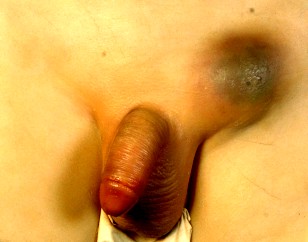
Modeller: S. Littre
Inguenal Bubo of the Lymph (1937)
felt they could be driven away with medicines. "Sometimes, and in the very beginning (if the Malignity is little) they are carried off by good purging ...and the application of a Diachalon cum Gum. Plaster, which discusseth [disperses] the impact humour, and so you hear no more of it."1 He notes that less malign buboes tend to 'rise leisurely', which would indicate that they can be treated in this fashion.
Moyle distinguishes those from more malign buboes, which "tumifie [swell] and come on violently."2 He explains that these types "tend to suppuration [come to a head by forming pus], and then they are not to be repelled [diffused using medicines to dissipate the fluid in the tumor], nor yet discussed, by any means."3 Fellow sea surgeon John Atkins similarly warns that "A Malign, or Venereal Bubo is dangerous to repel, and should, from the beginning, be assisted to Suppuration by Emplasticks [plasters], Cataplasms [poultices], Cupping, and the like"4.
Moyle says that the best medicine in such a case is a compound cataplasm which he says "will speedily ripe and break the Buboes."5 His prescription for this is:
Photo: Wiki User Matthes
Basilicum Ointment Jar,
Pharmazie Historiches
Museum
Rx. Unguent. de Musilagin. [mucilage ointment] Basilicum major [basilicon ointment], Melilot. composit. [melilotus plaster] Ana [of each] parts equal, Ol. Lilior. [oil of lilies] q.s. [of a sufficient quantity] melt these together; and with a little Farina Fabar. [bean meal] make them into a Cataplasmick consistence, and apply it.6
This is not the only medicine which Moyle suggests for ripening venereal buboes. In his previous book, he recommended
Rx. Ung. Basil [basilicon ointment], maj. Valentiæ scabiosæ, é mucilaginibus [an ointment made from hog's lard and the sticky mucilage of scabiosa plants], Melilot Comp. [melilotus plaster] Empl. Scirrhosum Salmonis [a compound plaster created by physician William Salmon for treating tumors], q. s. [a sufficient quantity] f. Cataplasma. [make into a cataplasm].7
In a case study written up in 1708, he uses yet another prescription:
Rx. Mucilag. Ex. rad lillior. Alb. [mucilage made from white lily root] {2 ounces}. Axung. Porcin. [pork lard] {3 ounces} Pulv. Croci. [powdered saffron] {1 dram} f. Catapl. [make into a cataplasm]"7. Not finding that medicine to be entirely satisfactory, he added "Ferment. Veter. [old yeast] & Pulp. Sicuum. [barley water extract] Ana. {of each, 2 ounces} this suppurated it speedily being repeated warm"8.
Photo: Mission - Lancet From Period Pocket Kit (Reproduction)
Once the medicine had matured the bubo and brought it to a head, Moyle felt it was up to the surgeon to finish the job. He advises his reader, "when they are ready, do not stay for their breaking of themselves, but open them with your Lancet in the depending part, and let them run plentifully."9 In a case study, he details his own actions: "I opened it by incision, and let out a great deal of Corrupt Sanies [serum, blood and/or pus]."10
Once opened, the would could be cleaned and filled with healing medicines. Here, Moyle advises the use of a syringe to inject medicines into the incised skin. In his first book, he recommends that the surgeon
cleanse the Ulcer with aqua phagad. [Phagadenick Water, used to cleanse sloughing ulcers] And spirit of Wine, and heal it with Balsamum Vulnerarium Salmonis, or Essentia Sulphuris [sulfur], on Dorcels [dossils, pieces of soft cloth] or soft Tents [cloth inserted into a wound]; and Emplastrum Diach. cum Gum. over all; which method certainly cures the sevearest of Claps.11
In his next book, Moyle doesn't specifically mention cleansing the opened wound, although he implies doing so. He suggests treating the opened tumor with "Vin. alb. [white wine] & Aq. Prunell. [Water of sloes] wherein Terebinth. [turpentine] hath been washed, and add Mel Rosar [honey of roses] an. [of each] parts equal. Fiat [make into a] Lotion, to wash the Ulcer warm, by Syringe."12 Once this is finished, the wound should be dressed with tents or
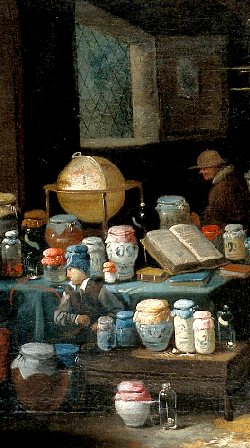
Artist: Egbert van Heemskerck - Pharmacy (17th c.)
dossils armed with healing basilicon unguent and covered with suppurating Diachylon cum Gummi as previously suggested. In his case study, he injected "aq. Plantag. [plantane water] & Flor. Egyptiac [Hypericum or St. John's wort flowers] misce. [mixed] and warm"13. He again follows this with dressings treated with basilicon unguent and Diachylon cum Gummi.
Moyle also recommends giving an alexipharmac drink, which resists poisons. His idea is that it will "help to drive out the venomous humour, which nature is heaving at; and to hinder a father progress of [the venereal] infection."14 For this Moyle provides a somewhat confusing drink prescription: "Rx. Liquor. Alexipharmicum [an anti-poison drink] seu [or] scorbutitum, [an anti-scurvy drink - the ingredients of these vaguely-named potions are not clear] sarsa. [sarsaparilla] Guiac. [guaiacum] ana [of each] {8 ounces} Gum. Guiac. [guiacum resin] {1 ounce}, Suc. Liquor. [the juice] {4 ounces} Spirit. Vini rectif. [rectified spirit of wine] {8 pounds}, mix, digest twenty days, decant and keep it for use."15 Two spoonfuls of this medicine were to be given in small beer each morning and evening as well as whenever the patient drank anything.
Because the goal of 'ripening' a tumor is to draw the poison to the top of the sore, the sea surgeons all agree that no humor-based procedures should be used which would make the material in the tumor flow inward. Moyle warns not to give the patient purging medicines16 or let him blood.17 He explains that such procedures can "hinder Suppuration of the Tumour, and recal the Contagious Humor inwardly, so as to mix with the Blood."18 This was thought to be the method for driving a first stage clap into a second stage pox, something which will be explored in detail later in this article. Atkins advised the use of cupping, which involved placing a glass bulb open on one end with all the oxygen burned out of it over the bubo. As the glass cooled, a vacuum would form, drawing the swelling up and out in a manner similar to the medicines Moyle recommended.
Once the tumor had been opened, "then you may purge and bleed, to consummate your Cure of Buboes."19
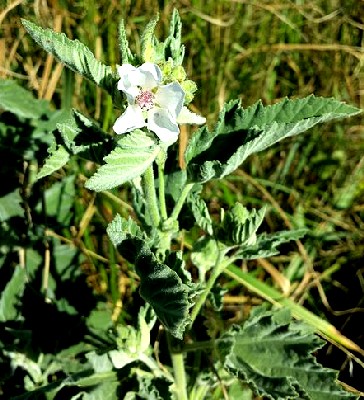
Photo: Stefan Lafnaer - Althae Officinalis (The Marshmallow Plant)
In his case study, Moyle recommended purging the patient using "Pil. ex duob. {2 scruples} Calomel [see the section on mercury on this page] {1 scruple} Misce. [mixed] this every third Day, and sometimes with Lenitive Electuary {1 ounce} and the Calomel mixed with it."20
Moyle mentions treating small closed sores on the penis, although in a manner different from buboes and tumors. In his first book, he explains that "if little Ulcers, Shankers, Pustules, &c. be on the Glans, or between that and the prepuce [foreskin], touch them with Flor. Egyptiac. [Hypericum or St. John's wort flowers] or sometimes album Camphoratum [white camphor] will do"21.
He mentions here that if unnatural swelling accompanies these little sores, Emplastrum Stipticum (Paracelsus) mixed with Ointment of Marshmallows will reduce the swelling. This is expanded upon in his next book where he notes that gonorrhoea can be accompanied by "Inflammation and Pimples on the Penis, and ...small Shankers on the Glans [end of the penis], [where] the Yard is Tumefied [puffy and swollen] and Pained"22. He gives a much fuller explanation of the cure here, although it is mostly a refinement of the older treatment.
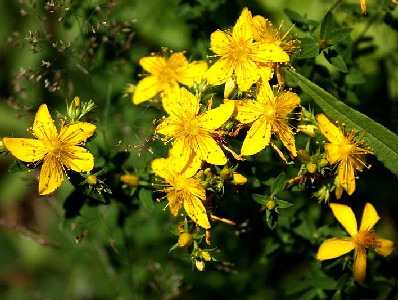
Photo: Leslie Seaton - St. John's Wort Plant and Flower
And [for] the Tumifaction, foment with Decoct. Althææ [ointment of marshmallows], then anoint the Pimples with Unguentum alb. Camph. [unguent of camphor and egg white] and if [there are] little Ulcers, touch them with Mellis Egypitaci [honey of St. John's Wort, the more fluid part of the unguent], and apply a Paracelsi Plaster [Emplastrum Stripticum] about the Penis. This with your second purging and astringing, consummates this Cure.
And then you may let the Patient blood, with good success.23
Sea surgeon John Woodall does not discuss treating small closed sores on the penis, but he does suggests a cure for unnatural swelling of the shaft of the penis caused by venereal ulcers. His advice is similar to that of Moyle, recommending that "by the use of Lotions mixed with Plantane or faire water [spring water] dayly warme, and cast it in twixt the Glans [head] and Preputum [foreskin], it will soone amend."24
1,2,3 John Moyle, Chirugius Marinus: Or, The Sea Chirurgeon, 1693, p. 141; 4 John Atkins, Lues Venerea, not dated, p. 35; 5 Moyle, Chirugius Marinus, p. 142; 6 Moyle, Chirugius Marinus, p. 141-2; 7 John Moyle, Abstractum Chirurgæ Marinæ, 1686, p. 92; 8,9 John Moyle, Memoirs: Of many Extraordinary Cures, 1708, p. 83; 9 Moyle, Chirugius Marinus, p. 142; 10 Moyle, Memoirs, p. 82; 11 Moyle, Abstractum, p. 92-3; 12 Moyle, Chirugius Marinus, p. 142; 13 Moyle, Memoirs, p. 82; 14 Moyle, Abstractum, p. 91-2; 15 Moyle, Abstractum, p. 92; 16 Moyle, Abstractum, p. 91 & Moyle, Memoirs, p. 82; 17 Moyle, Memoirs, p. 82; 18 Moyle, Memoirs, p. 82; 19 Moyle, Chirugius Marinus, p. 143; 20 Moyle, Memoirs, p. 82; 21 Moyle, Abstractum, p. 91; 22 Moyle, Chirugius Marinus, p. 140; 22 Moyle, Chirugius Marinus, p. 140-1; 24 John Woodall, the surgions mate, 1617, p. 159

